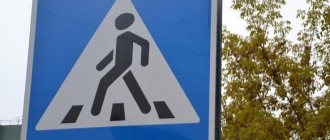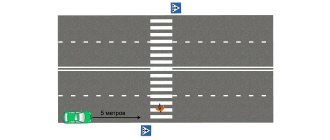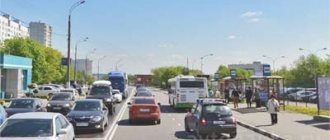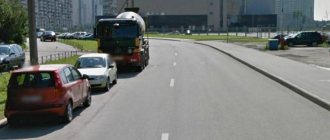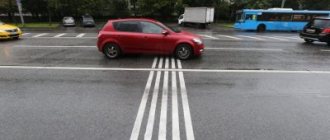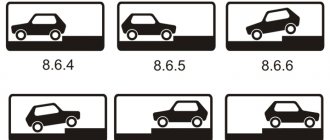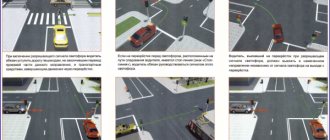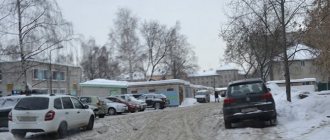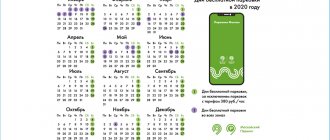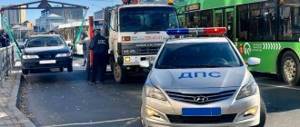Where is it allowed to park?
So, as stated above, the traffic rules in force for 2021 do not regulate places where it is prohibited to park a car. The rules do not directly permit, but establish where parking is prohibited, and also prescribe how and at what distances one can park.
According to the general absence of prohibitions and traffic regulations:
- it is allowed to stop on the right side of the road (clause 12.1 of traffic rules),
- Is it possible to park directly on the roadway - yes, but only if there is no shoulder,
- it is possible on the left, but only if the road is one-way (except for trucks over 3.5 tons) or two-way with 1 lane in each direction in populated areas,
- it is allowed to park the car in any place, but only in case of a forced stop - in case of a technical malfunction or poor condition of the driver or passengers (clause 1.2); At the same time, the emergency lights must be turned on and the AO sign must be displayed.
This is an exhaustive list of permissible conditions for parking or stopping a car according to current traffic regulations. Now let's look at special cases of this issue.
Signs where you can park your car
There is no sign specifically permitting parking in the Rules. Not a single section of road signs (and markings either) has one with the title “Stopping is allowed,” because, as we said above, traffic rules are not directly permitted, they are prohibited and regulated.
But there are a number of them that one way or another explain where you can park and under what signs you can’t. That is, almost any indication on a pole on the road is not related to parking rules, but there are signs that may indirectly indicate a prohibition. Let's take a look at them!
You will also be interested in:
- What is the penalty for making a U-turn at a pedestrian crossing and when is it prohibited by traffic regulations?
- All about overtaking: fine or deprivation? At crossings, intersections, under signs and across solid
- Is there a fine for waffle markings and what is it?
Stopping and parking is prohibited
So, the first negative answer to our main question: “is it possible to park here!” contained in the instructions of the most obvious series of road signs.
This is what they look like, and absolutely all car enthusiasts, young and old, know them:
All signs of approaching the crossing
One way or another, they indicate that there will soon be an intersection with the railway tracks and are installed in front of them:
- after 50-100 meters in populated areas,
- after 150-300 meters outside of them.
And clause 12.5 of the Rules prescribes that parking is prohibited closer than 50 meters to such an intersection with tracks. Please note that we are talking specifically about parking – this is parking lasting more than 5 minutes. But you can park directly under the sign if you do not block it from visibility by other drivers with your car (Section 12.4 of the Traffic Regulations)
Dangerous turn, steep descent or ascent
These signs are also warning signs, and if they are installed, it means that soon it may be impossible to park. And you will be fined for this, but only if the visibility of the road is less than 100 meters. This is indicated in paragraph 12.4 of the traffic rules.
12.4 Stopping is prohibited:
- …
- on the roadway near dangerous turns and convex breaks in the longitudinal profile of the road when the visibility of the road is less than 100 m in at least one direction;
the main road
Another non-obvious road sign that indicates a parking ban is 2.1 “Main Road”. It, according to paragraph 12.5, symbolizes the beginning of a section of the road with a parking ban for more than 5 minutes. But an important condition is that this rule applies only in populated areas.
Intersection or junction
This series of road signs actually indicates the approach to intersections and is installed 50-300 meters in front of them. And to find out whether it is possible to park in the chosen place, you need to measure 5 meters and park the car no closer than this distance to the intersection of roadways (Section 12.4 of the Traffic Regulations).
The “Give Way” sign has the same effect.
Motorway
On highways, stopping outside specially designated places is expressly prohibited - clause 16.1 of the traffic rules.
One way traffic
Is it possible to stop on the left on the one-way road? It depends on the weight of your car. If you are on such a section of the road, then you can park at the left edge of the roadway, and not just on the right, if you are driving a car with a permissible maximum weight of no more than 3.5 tons.
Road with bus lane
The presence of this sign directly indicates that parking is prohibited on the roadway of such a road, since it is prohibited to stop in the lanes for route vehicles, even to pick up and unload passengers. Of course, if you do not drive a taxi or a minibus. Clause 18.2.
What is the fine for parking under a “No Stopping” sign?
In order to identify the differences between these concepts, you need to know what a stop is and what a parking is, the definition of each maneuver separately.
In simple terms, these terms differ in their duration. Stopping is a short maneuver. The parking lot is long. But there are other differences as well.
A stop is a deliberate cessation of movement of a vehicle for up to 5 minutes, but traffic rules allow for exceeding this period.
Chapter 12 of the traffic rules describes the rules for stopping and parking vehicles. In accordance with them, the vehicle can be parked in the following places:
- Stopping and parking of vehicles is allowed on the right side of the road on the side of the road.
- If it is absent - at the edge of the roadway.
- In certain cases established by traffic regulations - on the sidewalk.
At first glance, technical safety features that are completely easy to remember, presented in the form of two round shields with a red border and a blue fill with one diagonal and two crosswise stripes, cause a lot of trouble for drivers, forcing them to waste time searching for a permitted parking space.
There are often situations when unsuccessful searches or accidental/specific ignoring of these prohibition signs resulted in fines or even evacuation of the vehicle with further searches in all city parking lots.
In order to insure yourself against any negative consequences, you need to learn the meaning of road signs and strictly follow the instructions encrypted in them.
In the case of the “SZ” traffic control system with one red diagonal stripe, listed in the traffic rules under number 3.28, you should remember that it actually prohibits parking, but allows stopping.
The operation of OS and SZ is often regulated by additional information signs, which can be installed immediately under the sign or duplicate it at some distance.
For example, a double-headed arrow indicates that a prohibited or restricted area extends both before and after the sign. If the arrow goes down, then you cannot stop or park only until this sign.
- Prices
- Characteristics
- Test Drive
- Four-wheel drive
- Trunk
- Photo
- Video review
- News
- Lada Vesta Cross sedan
“Parking” is the intentional cessation of movement of a vehicle for a period of more than 5 minutes for reasons not related to the embarkation or disembarkation of passengers or the loading or unloading of the vehicle.
That is, any cessation of movement for more than 5 minutes, if it is not passengers or unloading of cargo, then this is parking, two different concepts and do not confuse them!
A pedestrian crossing, according to the current version of the traffic rules, is a part of the roadway that is intended for the movement of people along it. The prohibition of stopping vehicles directly on the zebra crossing territory and at an unacceptable distance from it is associated with the following factors.
- Stopping or parking on the site itself for pedestrians makes it impossible for them to cross the highway. In this case, you will have to cross the road in another place, and this is fraught with the creation of an emergency situation and forced violation of traffic rules.
- If the car owner stops the car in front of a pedestrian crossing, this situation is also potentially dangerous, since the vehicle blocks part of the roadway. A person who crosses the road is deprived of the opportunity to assess the distance to the nearest moving cars.
- A driver may not notice a pedestrian from behind a parked car, which can lead to dire consequences.
In accordance with paragraph 4 of Article 12 of the Traffic Rules, stopping near a crossing can only be done at a distance of more than 5 meters. In this case, one feature must be taken into account. If there is a zebra crossing, this distance will be determined precisely to it. If it is missing, then the established road sign will become the starting point. Paragraph 5 of Article 12 of the Traffic Regulations strictly prohibits parking at the crossing and at a distance closer than 5 meters to it.
According to paragraph 4 of Article 14 of the Traffic Regulations, if there is a traffic jam that has formed after a crossing, the motorist does not have the right to drive onto it. The ban is due to the fact that the driver will not be able to cross the zebra crossing and will be forced to linger on it. In this case, he will inevitably face a fine for parking at a pedestrian crossing.
When considering what a fine for stopping at a pedestrian crossing may be, it is worth noting that in order to be held accountable, it is necessary that the fact of the violation be recorded. In fact, the driver may be subject to sanctions in the following situations.
- If the violation is recorded by a traffic police officer.
- When the fact of the stop is captured by CCTV cameras.
- Subject to filing a complaint from third parties. Such an appeal must be accompanied by photo or video materials that clearly show the license plate number of the car and the violation itself.
The penalty will be determined in accordance with the Code of Administrative Offenses of the Russian Federation in its current edition. In this case, the provisions of Article 12.19 apply, which determines the amount of the penalty for violation by motorists of Article 12 of the Traffic Rules.
- Part 3 – when a car stops at a crossing or closer than 5 meters from it, a fine is imposed on the owner of the car. Its value will be 1 thousand rubles.
- Part 6 - in case of a violation reflected in paragraph 3, but committed on the territory of Moscow or St. Petersburg, the fine increases to an amount of 3 thousand rubles.
Certain situations may be considered an exception and the motorist will not be penalized for stopping at a zebra crossing. These include:
- sudden appearance of an obstacle on the roadway;
- a sharp deterioration in the driver’s health;
- sudden breakdown of the vehicle;
- a danger to a motorist or other traffic participant.
In such situations, it is necessary to provide evidence of the occurrence of the circumstances, otherwise a fine cannot be avoided.
Violation of traffic rules in relation to stopping a vehicle at a pedestrian crossing leads to the motorist being held accountable and subject to an obligation to pay a fine. If you are guided by certain motives and park your car in a prohibited area, you should not forget that such actions can cause an emergency and even the death of road users.
- By car and driver
- By resolution number
The new standard introduces new permissible dimensions of road signs - 400 or 500 mm. For a square sign this will be the length of the side, for a round sign it will be the diameter. Reduced road signs of 400 mm size can be used:
- on unpaved roads outside populated areas
- in populated areas, if the road has no more than 3 lanes and passes through historical or densely built-up areas
Reduced road signs of 500 mm size are used:
- Outside the populated area on single-lane roads.
- In a populated area, if the road has 2 to 4 lanes.
Note that reduced size road signs are widely used in European countries. Both new standards are smaller in size than what was allowed before 2021.
There are often cases when intersections are located next to each other, or there is a complex junction ahead. Lane traffic signs on a white background indicate the direction of movement from the lane above which they are installed at the NEXT intersection. Based on these signs, you can pre-select the optimal lane for driving. Very useful signs for large cities.
- Everything about replacing a driver's license
- Everything about car registration
- Getting your driver's license for the first time
- All about deregistration with the traffic police
- Passing technical inspection 2019
- New rules for registration of road accidents
- Drawing up a purchase and sale agreement
The entire list of circumstances that may prohibit stopping is in paragraph 12.4 of the traffic rules. Among them there are also stopping places for route vehicles. The rules say that drivers are prohibited from stopping not only directly at the public transport stop, but also within a radius of 15 m from them in both directions. The boundaries of the stop must be considered the boundaries of marking 1.17 or the location of the sign 5.16 - another 15 meters must be measured from them.
There is no clause in the traffic rules that would specifically indicate that parking is prohibited at public transport stops. But in paragraph 12.5 of the traffic rules there is a remark that parking is prohibited in any places where stopping is prohibited. Consequently, parking at a bus stop is prohibited, since the conditions when stopping at them are permitted are an exception to the rule, and not the rule itself.
The law also provides certain advantages for taxi drivers: they can have their own parking spaces, they can also use the lane allocated for buses. However, the benefits of taxi drivers do not apply to route vehicle stops: they are recognized as ordinary drivers. A taxi driver can stop at this location only to pick up and drop off passengers and only in such a way as not to interfere with the movement of buses.
- Car loans
- All about OSAGO
- All about CASCO
- Car insurance
- Car taxes
- Road accident - what to do?
- All about carsharing
- Fines
- Registration actions
- Communication with the traffic police
- To help drivers
- Calculate transport tax
- Calculate OSAGO
- Calculate CASCO
- Calculate car loan
- Calculate fuel consumption
- Car customs clearance calculator
The traffic rules define these concepts. So, parking is a place on a part of the road, specially designated, or equipped with signs or markings. It may be adjacent to a roadway, a sidewalk, a simple shoulder or a bridge. In other words, this is an organized parking place.
Parking is a stop of transport for more than 5 minutes (provided that this action is not associated with boarding passengers or loading cargo). A simple example of a parking lot: a citizen left his personal vehicle near his house, and after stopping does not plan to go anywhere.
Parking, parking and stopping have main differences, we list them:
| Parking | This is a place set aside on the road for temporarily rendering vehicles inoperative. Usually you can park your car for free for only a short time. For example, a family arrived at the store, the car was parked in a designated place while shopping was done. |
| Stop | This deliberate action is performed to temporarily stop the movement of the machine (no more than 5 minutes). In this case, passengers are boarded or disembarked, or passengers are loaded (unloaded). |
| Parking | This is the name of the manipulation when a citizen stops the movement of the car for a long time, it is not related to the boarding of passengers. Citizens have no obligation to report the reasons for parking. |
Taking into account the differences, certain rules are established for parking.
How can you stand on the sidewalk?
According to general rules, parking on the sidewalk is prohibited. But there is an exception - when a special sign is installed along with a sign:
- 6.4 means you can park here,
- plates 8.4.7, 8.6.2, 8.6.3, 8.6.6-8.6.9 with a way to park the machine.
Another opportunity to stop on the sidewalk is to deliver cargo for unloading/loading to the site if there are no other options to get there.
Where is it allowed and where is it forbidden to park?
The method of stopping a car or parking is determined by sign 6.4 . When a sign is combined with plates 8.6.4-8.6.9 and road marking lines, parking a vehicle is permitted at an angle to the edge of the roadway if the space allows such an arrangement.
- Parking lot: A place where a vehicle is placed in a non-operational state and left for a short period of time. The car is not guarded during long-term parking. You can leave your car for free for a short period of time.
- Stopping: intentionally stopping movement for up to five minutes. In this case, people are disembarked or embarked, cargo is unloaded or loaded.
- Parking: cessation of traffic for more than five minutes, which does not involve boarding passengers. The driver is not required to report the reasons for it.
At stops
The ability to park at a bus or other stop depends on a number of factors:
- is there a bus lane on this section - you should not stop under any circumstances unless you are on a minibus or taxi,
- how many meters from the stop - maybe 15 meters before the corresponding sign or marking (in the absence of the same designated lane),
- Are you parking only to pick up/drop off passengers? It’s possible for these purposes (again, in the absence of a bus lane), but only if you don’t interfere with the movement of public transport.
This is an exhaustive list of possibilities to park a car at stops.
Stopping at a bus stop - who is allowed
A fine can be issued not only during a personal meeting with the inspector, but also if the offense was filmed by stationary recording devices (photo or video). If the offender agrees with the fine, 60 days are given to pay. The countdown of the period begins from the moment of delivery of a copy of the decision on the offense.
The traffic rules state that stopping at bus, trolleybus stops and minibus stops is prohibited. This applies to both the “pocket” for bus stops and the entire zone 15 meters long before the pocket, and 15 meters after. Prohibited areas are marked with signs and road markings familiar to every motorist.
Also read: What documents are needed to receive a tax deduction for education?
How long before the transition?
Clause 12.4 of the Rules stipulates that stopping at pedestrian crossings is prohibited. But the traffic rules also stipulate that you can park more than 5 meters before the crossing.
The legislation of 2021 does not establish how long before you can stop after a zebra crossing. This means you can stop right behind it:
- after completing the corresponding marking,
- after the sign for the end of the pedestrian crossing immediately behind it in the absence of markings.
How long should it be before the continuous marking?
3 meters. This is established by paragraph 12.4 of the Traffic Rules. Moreover, if there are no markings, then you should count to the other edge of the roadway (not the shoulder).
But we are talking about solid or double solid lines that separate oncoming and passing traffic, as well as passing traffic into lanes. Undivided white markings can also be to the right of the car - in cases where it marks the edge of the roadway or a parking space. Is it necessary to write that in this case there can be no talk of any 3 meters to the continuous line.
On lawns and courtyards near houses
But this case is no longer described in the traffic regulations in force for 2021. You simply won’t find a ban on parking on a lawn, or a definition of a lawn in the Rules. And also a similar ban on courtyard areas.
But indirectly this issue is regulated by clause 12.1:
12.1. Stopping and parking of vehicles is permitted on the right side of the road on the side of the road, and in its absence - on the roadway at its edge and, in the cases established by paragraph 12.2 of the Rules, on the sidewalk.
The lawn does not belong to the roadway and the side of the road. It is not part of the road at all. Therefore, stopping there is prohibited. A similar prohibition is contained in the legislation of the constituent entities of Russia. Thus, the laws of Moscow and St. Petersburg define a lawn and directly state that parking there is prohibited. At the same time, it is not necessarily the presence of grass that is considered a lawn - a piece of bare earth also formally fits this definition.
Similarly, a fine for stopping on the lawn is issued at the level of individual cities. It varies by region and ranges from 4 to 5 thousand rubles.
There is also no direct ban on parking in courtyards. But there are traffic rules in the courtyards. This is where the prohibitions arising from the traffic rules follow. And most often, drivers who leave cars in courtyard areas may violate the following regulations:
- what we have already discussed above - parking on the lawn,
- less than 3 meters to the opposite edge of the roadway (clause 12.4),
- the car is not parked parallel to the inverter (clause 12.2).
Parking in the courtyard of an apartment building: what not to do
First, let's talk about what is strictly prohibited. Firstly, you cannot park your vehicle on lawns and sidewalks, as these areas are intended for pedestrians, not your cars. It is also strictly prohibited to block free passage.
Therefore, the car must be parked in a specially designated place, of course, if there is one. Consequently, other cars, as well as ambulances, police, fire, and gas services must have free access to each entrance of a multi-story building. It is worth paying attention to the presence of shops near your home. You cannot park your vehicle closer than 10 meters from the doors of such an establishment. This is due to the fact that a car with goods may arrive, but the road will be blocked. If your car sits in the wrong place for too long, then there is a high probability that a special service will arrive and take the vehicle to a impound lot, or angry residents of the house will damage your car.
On the marking
The most mentioned paragraph 12.1 in this article indicates that parking can only be done on the right on the roadway or side of the road, and also in some cases on the sidewalk. The traffic rules do not directly say a word about markings. And this means that we again need to look at indirect violations of other points.
And then the following rules apply to us.
- 1.1. Continuous - stopping on it is prohibited if it divides oncoming or passing traffic into lanes, since this will be a stop beyond the first row. In addition, you cannot park your car on the markings dividing parking spaces.
- But you can park at marking 1.2, as it marks the edge of the roadway.
- 1.3. Double solid: prohibited for the same reason why it is not allowed on line 1.1.
- 1.4-1.15 – prohibited.
- Series of lines 1.16 – we will look at them a little lower.
- It is also prohibited to park your car on other markings.
Safety islands
We are talking about a series of markups 1.16.1-1.16.3. Here the markup 1.16.1 may cause a controversial point. Here is the official text of the 2021 traffic rules citation:
1.16.1 – denotes islands separating traffic flows in opposite directions, places for parking vehicles (parking) and bicycle lanes;
That is, you can read this wording in 2 senses:
- denotes... places for parking vehicles (parking),
- denotes islands separating ... places for parking vehicles (parking).
That is, in the first sense you can stop, but in the second you cannot. But, most likely, the meaning of paragraph 2 is embedded in the quote - that is, we do not recommend parking and stopping on such an island.
cars in the yards
And now I would like to talk about how and where you need to place your iron horse. Despite the fact that there are a lot of options here, the majority still prefer to do what is convenient for them, but as practice shows, complaints from neighbors come very quickly, as do broken car windows, damaged paintwork, broken wheels, etc. unpleasant moments . You probably haven’t thought about the fact that there are special parking rules. Traffic rules, clause 26.2. “About parking in a residential area.” It clearly states that the vehicle must be parked in specially designated areas. There are several options here. This could be paid parking near your house or special places directly in the yard where you are required to park your car. As practice shows, there are always not enough such places, and in most cases, they simply do not exist.
At the crossroads
Clause 12.4 of the Rules - you cannot park the car at the intersection of roadways. They are the ones who form the crossroads.
In addition, the same norm of the by-law indicates how much before the intersection you cannot stop - closer than 5 meters before the intersection of the roadways.
Something else useful for you:
- Bus lane according to traffic rules and fines for driving and stopping on it in questions and answers
- Road sign “Parking prohibited” according to traffic regulations: what is the coverage area, where and who can park?
- What is the fine for crossing solid markings dividing parking spaces?
Operation of stop and no parking signs
- sign 3.27 - stop and parking sign is prohibited;
- No parking sign with information signs
- signs 3.29 and 3.30 - no stopping sign (+ on even and odd days of the month + with information signs)
Area of operation of the stop and parking sign is prohibited
Area of operation of the “No Stopping” sign
Each of these signs imposes its own restrictions, which are more complex.
Rules for stopping and parking vehicles: video course
Where can large families park for free?
Only in paid parking zones in Moscow and St. Petersburg, subject to residence in these cities, respectively. Or at places allowed for stopping according to traffic regulations.
In paid parking lots, large families can stop for free if all the following conditions are met simultaneously:
- there are at least 3 children in the family,
- all children are minors,
- a permit has been obtained for this vehicle.
Thus, you cannot just come and park your car in a paid parking zone, being a parent with many children. To do this in 2021, you must first obtain a special permit. It is issued at the MFC if there are documents about having many children.
What are the fines?
There are a dozen penalties for violating parking rules in places where it is prohibited. The good news is that you cannot lose your license for an incorrect stop (with rare exceptions), but the bad news is that the penalties may exceed the cost of paid parking.
Let's look at them all!
Fines for illegal parking
| Article of the Administrative Code | Amount of fine, rubles | Is evacuation planned? |
| 12.16, parts 4 and 5 – Parking under a prohibition sign or on markings | 3000 for Moscow and St. Petersburg 1500 for other cities | Yes, but only if there is an evacuation sign (Article 27.13 of the Administrative Code) |
| 12.19, part 2 – Stopping and parking in places for the disabled | 5000 | Yes |
| 12.19, parts 3 and 6 – Parking on a zebra crossing or less than 5 meters in front of it, violation of stopping on the sidewalk | 3000 for Moscow and St. Petersburg 1000 for other cities | Yes |
| 12.19, parts 3.1 and 6 – At designated stops (if there is no interference with minibuses, otherwise see part 4 of article 12.19) and closer than 15 meters in front of them | 3000 for Moscow and St. Petersburg 1000 for other cities | Yes |
| 12.19, parts 3.2 and 6 – Stopping further than the first row of the edge of the roadway or on tram tracks | 3000 for Moscow and St. Petersburg 1500 for other cities | Yes |
| 12.19, parts 4 and 6 – Parking that interferes with other participants, or in a tunnel | 3000 for Moscow and St. Petersburg 2000 for other cities | Yes |
| 12.10, part 1 – Stopping and parking at the railway crossing | 1000 rubles or deprivation of rights for 3-6 months | No |
| 12.10, part 3 – Repeated parking at the railway crossing | Deprivation of rights for a year | No |
| 12.10, part 1 – Any other traffic violations regarding parking not listed above | 500 | No |
Parking in front and behind the pedestrian crossing
- On rails intended for trams, as well as near them;
- At railway crossings, bridges, tunnels, overpasses, etc.;
- At the zebra crossing and closer than 5 meters in front of it;
- Less than 15 meters from a public transport stop. It can be indicated either by markings or by a sign. The exception is the embarkation and disembarkation of people;
- On a road with dangerous turns or heavy traffic;
- In a lane reserved for cyclists;
- If your car interferes with other road users. For example, it will interfere with pedestrians, obscure road signs or traffic signals from other motorists, etc.;
- At an intersection and closer than 5 meters from the edge of the roadway (the one you are crossing);
- If the distance between your car and the solid line demarcating the lanes (if any) is less than 3 meters.
- Parking or stopping directly on the zebra crossing is prohibited.
- Parking in front of a pedestrian crossing is possible and acceptable if there is more than 5 meters left to it.
- If you want to leave your car behind a zebra crossing, remember that you cannot run over the markings.
- Estimate the width of the stripes if they are separated by a solid marking line. Your car must not interfere with the movement of other vehicles; for this, the distance from the solid line to the parked car must be 3 meters or more.
01 Aug 2021 stopurist 12397
Share this post
- Related Posts
- Payments in 2021 for a Guardian Child in the Krasnodar Territory
- You need to pay money if you enter into an inheritance
- Sample order to extend a fixed-term employment contract
- Deadline for payment of 3 personal income taxes in 2021 for individuals
